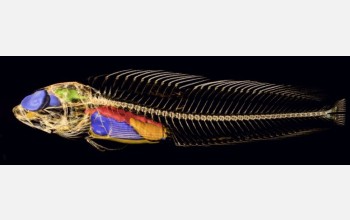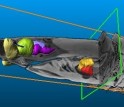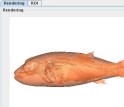News Release 06-046
Project Takes Fish Collection into the Digital Age
Novel application of MRI leads to new tools for online dissection of preserved fishes
March 17, 2006
This material is available primarily for archival purposes. Telephone numbers or other contact information may be out of date; please see current contact information at media contacts.
The same medical technology used to image brain tumors and torn knee ligaments is now taking the field of marine biology to a new dimension: anyone with Internet access will be able to look at fish as never before.The National Science Foundation (NSF) has awarded researchers at the University of California at San Diego's (UCSD) Keck Center for Functional Magnetic Resonance Imaging (fMRI) and Scripps Institution of Oceanography a grant to use magnetic resonance imaging (MRI) to create a high-resolution, 3-dimensional, online catalog of fishes.
"This project will augment the existing Scripps Marine Vertebrate Collection by using a new tool and a new way to present information about fishes," said collection curator Philip Hastings. "It's part of our general effort to make the collection more available to a wider audience."
UCSD School of Medicine's Lawrence Frank, who leads the biomedical applications program at the Keck fMRI Center, will direct the project. He said the undertaking will further push development of MRI technology for unique applications in humans as well as other species.
"This project also shows the growing role of cutting-edge imaging and computer technologies in increasing our access to information about not only marine biology, but biodiversity and global ecology as well," said Frank.
The five-year, $2.5 million Digital Fish Library project will support development and application of new MRI technology that, in conjunction with novel data analysis and visualization methods, penetrates soft body tissue to provide 3-D images of physiological structures.
"The project uses digital imaging technology to open the inner workings of vertebrate fish without destroying precious specimens," said Manfred Zorn, program director in NSF's Division of Biological Infrastructure, which funded the project. "It will also open the collection to researchers around the world, who will be able to access images via the internet."
The plan is to image the internal anatomies of the entire range of fishes, said Hastings. "Capturing the variation across all fishes will open the door to a range of interesting questions about how species differ. You can imagine comparing the brain of a coral-reef fish that relies on vision with one from the deep sea that relies mainly on smell, or comparing the muscles of deep-sea fishes that regularly migrate to the surface with those that stay in the deep."
This variation is part of the challenge, as standard MRI is designed to image the anatomy of humans, who slide inside large cylindrical "coils" that capture data that is then processed to create detailed computer images.
"Fish come in a variety of odd shapes, so we have to develop new hardware to image them," said Frank. "Engineers at the center are building special coils for fish. We are also working on new ways of collecting data, because fish tissue can be very different from the tissues we typically image. By tailoring the technology, we will further optimize our use of MRI, whether we're imaging cardiac muscle, brain tissue, cartilage or fish."
The technology will enable researchers to acquire and process high-resolution data of various fish anatomies that can be placed on the Internet. Using this powerful and versatile imaging tool, scientists, students and anyone in the public will be able to digitally probe and dissect these fishes from a desktop computer anywhere in the world.
Scripps' Marine Vertebrate, or "Fish," Collection, is among the largest and most comprehensive collections of its kind, containing 90 percent of all known families of fishes. With more than 2 million specimens, the collection is used by researchers around the world to investigate the systematics, biodiversity, physiology, ecology and conservation of fishes. Through the Digital Fish Library project, coordinators will image at least one of every 482 fish families in the world.
Project coordinators will create a resource that allows scientists to remotely study the world's fish species, from the exotic to the mundane. In collaboration with the Birch Aquarium at Scripps, the scientists will also develop the "Digital Dissection Tool," an educational program for high-school students that capitalizes on the interactive scientific research aspects of the project.
"By creating the Digital Fish Library, we're developing a tool that stimulates students to think independently and naturally leads them into questions they might want to investigate," Frank said. "We hope to design an educational model that spurs students' interests and teaches them how to conduct research. It's not just teaching them about fish anatomy or physiology; it's teaching them about magnetic resonance imaging, computation and visualization."
Education modules within the Digital Dissection Tool will cover the basics of MRI, digital image processing of 3-D MRI data as well as aspects of marine biology. Under the guidance of co-investigator Cheryl Peach of the Birch Aquarium, elements of the project also will be incorporated into UCSD's Academic Connections Program, an intensive, three-week summer learning experience for college-bound high-school students.
Hastings said virtual dissections will help preserve fish specimens, unlike traditional, physical dissections that often destroy them. That is even more important with rare specimens. In a global environment in which marine species are being threatened by overfishing, pollution, climate warming and other risks, such resources have become increasingly important, he said.
-NSF-
-
Galapagos shark (Carcharhinus galapagensis)
Credit and Larger Version -
Spotted sharpnose puffer (Canthigaster punctatissima)
Credit and Larger Version
Media Contacts
Cheryl Dybas, NSF, (703) 292-7734, email: cdybas@nsf.gov
The U.S. National Science Foundation propels the nation forward by advancing fundamental research in all fields of science and engineering. NSF supports research and people by providing facilities, instruments and funding to support their ingenuity and sustain the U.S. as a global leader in research and innovation. With a fiscal year 2023 budget of $9.5 billion, NSF funds reach all 50 states through grants to nearly 2,000 colleges, universities and institutions. Each year, NSF receives more than 40,000 competitive proposals and makes about 11,000 new awards. Those awards include support for cooperative research with industry, Arctic and Antarctic research and operations, and U.S. participation in international scientific efforts.
Connect with us online
NSF website: nsf.gov
NSF News: nsf.gov/news
For News Media: nsf.gov/news/newsroom
Statistics: nsf.gov/statistics/
Awards database: nsf.gov/awardsearch/
Follow us on social
Twitter: twitter.com/NSF
Facebook: facebook.com/US.NSF
Instagram: instagram.com/nsfgov





